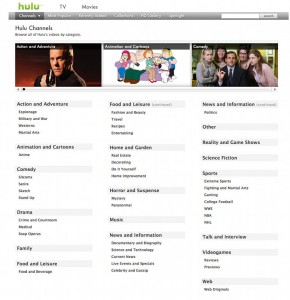Americans watching online videos, video ads in record numbers
Posted by Elena del Valle on February 17, 2010

Photos: Hulu, YouTube, Tremor Media
Americans’ thirst for online videos seems unquenchable (also see Americans are viewing online videos in record numbers). Last December, 178 million Americans watched 33.2 billion videos online, and Google was by far the main player in that space, according to information released earlier this month by the comScore Video Metrix service. ComScore is a Virginia based company specializing in digital media usage measurement. Most people connected to the Internet, 86.5 percent, watched videos with an average duration of four minutes.
Google sites visitors watched 13.2 billion videos and YouTube.com accounted for almost 99 percent of all videos viewed there. For the first time Hulu (NBC Universal, News Corporation and The Walt Disney Company share in the ownership stake of the company and are content providers) surpassed one billion monthly video streams or 3 percent of the market. Other significant players in the online video space included Microsoft sites, in third place, with 561 million or 1.7 percent; Fox Interactive Media with 551 million also 1.7 percent and Yahoo! sites with 539 million or 1.6 percent.
Each viewer watched an average of 187 videos in December. Some 136 million unique viewers visited Google sites watching 97.5 videos each during the month; 59.8 million Yahoo! sites fans viewed 9 videos each; and 56.8 million visitors on Fox Interactive Media watched 9.7 videos per viewer. Hulu viewers watched 22.9 videos each during the month, another record for the website.
Click on image to enlarge
What about ad reach? With a potential reach of 103.7 million viewers, 58.3 percent of the total audience, Tremor Media and BBE with a potential reach of 101.1 million viewers, 56.9 percent penetration, were the top video ad networks. The Advertising.com Video Network with 83.6 million viewers, 47 percent, was in third place.

Jason Glickman, chief executive officer, Tremor Media
“With our Acudeo technology tightly integrated within the player-environment across all of the sites in our in-stream network, Tremor Media is able to continually introduce new and innovative ad formats that can be reliably delivered at scale. These new formats benefit the entire video value chain – from advertisers to publishers to the end consumer – by putting the viewer in control, enhancing engagement, and making video advertising more effective for brands,” said Jason Glickman, chief executive officer, Tremor Media in a press release.
Things must be going well in the online video ad business. Tremor announced six new ad formats last month: Pre-Roll Plus Overlay, a clickable overlay that appears over the publisher’s content following a standard pre-roll; vChoice Select, allows the user to choose which video ad to watch before it’s delivered; vChoice Rotator, rotates multiple brand videos in a single unit, allowing advertisers with multiple video assets to offer fewer options as thumbnails within the vChoice menu, and rotate the options each time an impression is served to the same user; Data Feed, dynamically populates brand or location specific data within the ad unit automatically or via user input such as a zip code; Sequencer, offers a different creative for every sequential impression delivered; and In-Stream Live, a live video feed within the ad.
”Requests for Hispanic targeted campaigns tend to be geo-targeted to TX and CA,” said Shane Steele, vice president, Marketing, Tremor Media when asked about Hispanics and online video ads.
Very little information seemed to be available about online video ads targeting or viewed by Hispanics. No ethnic breakdown was included in the comScore data and none of the three ad leaders mentioned Latino ad campaigns specifically in their promotional materials online.
“Moving Beyond Traditional Media Measurement: measuring conversations and social media” audio recording

Presenter Katie Delahaye Paine, founder, KDPaine & Partners
Find out about
- Issues affecting online public relationships today
- Testing relationships as part of a survey
- Measuring ethnic group relationships
- Measuring foreign language communications in a similar ways to English
- Biggest challenges measuring conversations and social media
- Measuring online relationships with little or no money
Click here for information on “Moving Beyond Traditional Media Measurement”










